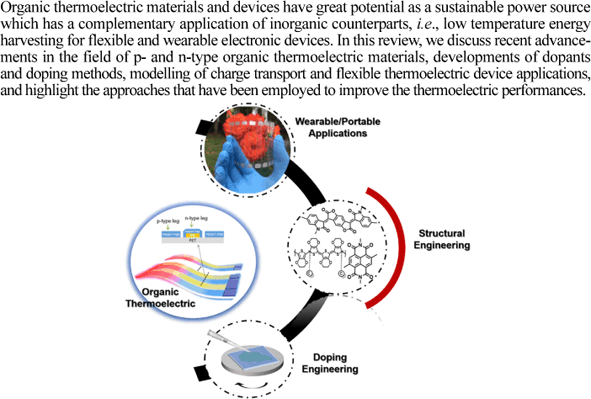当前位置:
X-MOL 学术
›
Macromol. Res.
›
论文详情
Our official English website, www.x-mol.net, welcomes your feedback! (Note: you will need to create a separate account there.)
Recent Progress in Organic Thermoelectric Materials and Devices
Macromolecular Research ( IF 2.4 ) Pub Date : 2020-06-23 , DOI: 10.1007/s13233-020-8116-y Soonyong Lee , Soohyun Kim , Ambika Pathak , Ayushi Tripathi , Tian Qiao , Yeran Lee , Hyunjung Lee , Han Young Woo
Macromolecular Research ( IF 2.4 ) Pub Date : 2020-06-23 , DOI: 10.1007/s13233-020-8116-y Soonyong Lee , Soohyun Kim , Ambika Pathak , Ayushi Tripathi , Tian Qiao , Yeran Lee , Hyunjung Lee , Han Young Woo
In recent years, thermoelectric (TE) devices have attracted a growing attention due to their promising ability to convert waste heat into readily available electric energy. Compared to inorganic counterparts, organic TE devices emerged as the potential candidates for room-temperature and flexible (even wearable) TE power generation. During last few decades, extensive studies have been performed on the p- and n-type materials and devices to build up the inter-relationship among the TE parameters (i.e., electrical conductivity, Seebeck coefficient, thermal conductivity and power factors), demonstrating a great potential of organic TEs. In this review, recent progresses in the organic TE materials and devices, dopants and doping method, charge transport models and flexible TE device applications are summarized and the key strategies and future prospects to further optimize TE performance are discussed.
中文翻译:

有机热电材料和器件的最新进展
近年来,由于热电(TE)设备将废热转换成容易获得的电能的能力,它们已引起越来越多的关注。与无机同类产品相比,有机TE装置已成为室温和柔性(甚至可穿戴)TE发电的潜在候选者。在过去的几十年中,对p型和n型材料和器件进行了广泛的研究,以建立TE参数之间的相互关系(即,电导率,塞贝克系数,热导率和功率因数),证明了有机TE的巨大潜力。在这篇综述中,总结了有机TE材料和器件,掺杂剂和掺杂方法,电荷传输模型和柔性TE器件应用的最新进展,并讨论了进一步优化TE性能的关键策略和未来前景。
更新日期:2020-06-23

中文翻译:

有机热电材料和器件的最新进展
近年来,由于热电(TE)设备将废热转换成容易获得的电能的能力,它们已引起越来越多的关注。与无机同类产品相比,有机TE装置已成为室温和柔性(甚至可穿戴)TE发电的潜在候选者。在过去的几十年中,对p型和n型材料和器件进行了广泛的研究,以建立TE参数之间的相互关系(即,电导率,塞贝克系数,热导率和功率因数),证明了有机TE的巨大潜力。在这篇综述中,总结了有机TE材料和器件,掺杂剂和掺杂方法,电荷传输模型和柔性TE器件应用的最新进展,并讨论了进一步优化TE性能的关键策略和未来前景。



























 京公网安备 11010802027423号
京公网安备 11010802027423号